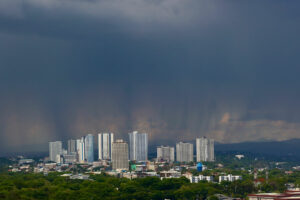




Policy Rate Updates: Double cut finale
 DOWNLOAD
DOWNLOAD

Monthly Economic Update: One for the road
 DOWNLOAD
DOWNLOAD

Inflation Update: Still low, still slow
 DOWNLOAD
DOWNLOAD


ADB, AMRO slash Philippine growth forecasts for 2025, 2026

A global slowdown and higher US tariffs have clouded the growth outlook for the Philippines, as the Asian Development Bank (ADB) and ASEAN+3 Macroeconomic Research Office (AMRO) both downgraded their Philippine growth projections for this year and in 2026.
In its latest Asian Development Outlook, the ADB slashed its gross domestic product (GDP) growth forecast for the Philippines to 5.6% for 2025 from 6% previously. For 2026, the ADB projects Philippine GDP to grow by 5.8% from 6.1% previously.
However, this would be within the government’s 5.5 to 6.5% target for this year, but below the 6-7% goal for 2026.
At the same time, AMRO cut its growth projections for the Philippines to 5.6% for this year and 5.5% for 2026 in its latest ASEAN+3 Regional Economic Outlook (AREO) report. These are lower than its previous forecast of 6.3% for both 2025 and 2026.
AMRO also cut the ASEAN+3 region’s growth outlook to 3.8% (from 4.2%) in 2025, and 3.6% (from 4.1%) in 2026, reflecting the impact of higher US tariffs that will take effect on Aug. 1.
“These (US) tariffs will likely reduce US demand, increase investment uncertainty and dampen consumer confidence. Given the broad scope of the tariffs, the associated slowdown in global growth would further weigh on the region’s outlook,” AMRO said in the report.
ASEAN+3 comprises the Association of Southeast Asian Nation (ASEAN) members plus China, Hong Kong (China), Japan and South Korea.
AMRO also cut the growth forecast for ASEAN to 4.4% (from 4.7%) this year, and 4.2% (from 4.7%) in 2026.
Based on the latest AREO, the Philippines is expected to be the second-fastest growing economy this year and in 2026, after Vietnam. Vietnam is projected to grow by 7% this year and 6.5% next year.
AMRO Group Head and Principal Economist Allen Ng said Philippine growth forecasts were lowered on expectations of slower global growth.
At a briefing on Wednesday, Mr. Ng said the Philippines’ weaker-than-expected 5.4% GDP expansion in the first quarter hinted that the “growth momentum is slower than initially expected.”
Mr. Ng said the country’s growth will likely remain strong, thanks to sustained private consumption, stable labor market conditions, slower inflation and “robust” remittance outlook.
He said the newly announced 19% tariff that the US will impose on Philippine goods is unlikely to change its forecasts.
“In the case of the Philippines, our assessment is that the impact will be very limited and it’s unlikely that we will materially change our forecast given the changes is actually from 20% to 19%,” he said.
However, Mr. Ng noted the impact of the higher tariffs remains smaller in the country compared with its Association of Southeast Asian Nations (ASEAN) neighbors given the Philippine economy is more focused on the domestic market.
“But there will be broader impact on global slowdown on the economy. So, this will affect both exports as well as business sentiment and investment activities in the Philippines,” he said.
For 2026, AMRO said the impact of the tariffs on ASEAN+3 is projected to be “more significant.”
“This is particularly so for regional economies which face both higher tariffs from the US and rely more on external demand. Overall, however, continued strength in domestic demand and sustained external demand for electronics and tourism is expected to continue to underpin regional growth,” it said.
More aggressive protectionist policies from the US pose a major risk to the growth outlook for the region, AMRO said, citing potential tariffs on exempted sectors, such as semiconductors and pharmaceuticals.
“As these products represent a substantial share of exports to the US for some regional economies, such measures could further dampen growth. Idiosyncratic considerations are also influencing tariff decisions, it said.
Other risks include a sharper slowdown in the US and Europe, tighter financial conditions, a spike in global commodity prices and weaker growth in China.
Meanwhile, AMRO lowered its inflation forecast for the Philippines to 1.8% from 3.3% for 2025. This is slightly higher than the Bangko Sentral ng Pilipinas’ (BSP) 1.6% average forecast for this year.
AMRO kept its projection for 2026 at 3.2%, unchanged from its April forecast. This is below the central bank’s 3.4% target forecast for 2026.
AMRO has noted that central banks in half of ASEAN+3 economies have eased monetary policy amid slowing inflation and tariff concerns.
“Headline inflation in the region is projected to remain low and stable at around 1% in 2025 and 2026. This outlook reflects stable commodity prices, including the normalization of oil prices following the temporary volatility during the brief escalation of Iran-Israel conflict,” it said.
ADB forecast
Meanwhile, the ADB still expects the Philippines to post the second-fastest growth in Southeast Asia this year and 2026, despite lowering its projections.
Vietnam is projected to grow by 6.3% this year, followed by the Philippines (5.6%), Indonesia (5%), Malaysia (4.3%), Thailand (1.8%) and Singapore (1.6%).
For 2026, Vietnam is still likely to post the fastest growth at 6%, followed by the Philippines (5.8%), Indonesia (5.1%), Malaysia (4.2%), Thailand (1.6%) and Singapore (1.5%).
In a statement, the ADB said it lowered its growth forecasts for developing Asia and the Pacific region this year and next year “driven by expectations of reduced exports amid higher US tariffs and global trade uncertainty as well as weaker domestic demand.”
It trimmed its 2025 growth forecast for the region to 4.7% from a projection of 4.9% made in April. It also cut the region’s growth outlook for 2026 to 4.6% from 4.7%.
“Asia and the Pacific has weathered an increasingly challenging external environment this year. But the economic outlook has weakened amid intensifying risks and global uncertainty,” ADB Chief Economist Albert Park said in a statement.
Southeast Asia is expected to post the slowest growth among sub-regions. ADB projects Southeast Asia growth at 4.2% in 2025 and 4.3% in 2026, lower than the earlier forecasts of 4.7% for both years.
“Economies in the region should continue strengthening their fundamentals and promoting open trade and regional integration to support investment, employment and growth,” Mr. Park said
According to the ADB, developing Asia and the Pacific comprises 46 economies ranging from China to Georgia to Samoa, and excluding countries such as Japan, Australia and New Zealand.
Remittance decline
In the same report, the ADB said the Philippines is expected to see the “largest proportional decline” in remittance inflows from the US once the US tax on remittances is implemented in 2026.
“In the rest of the region, the Philippines is projected to face the largest proportional decline, with US remittance inflows falling by the equivalent of 0.05% of GDP, followed by Vietnam and Nepal (both 0.03%),” it said.
On the other hand, India’s potential remittance loss would be the largest in absolute terms at USD 315 million, but accounting for 0.01% of its GDP.
Mr. Trump signed the “One Big Beautiful Bill” into law on July 4, imposing a 1% excise tax on cash-based remittances from the US to recipients abroad. The tax will be implemented starting Jan. 1, 2026.
The ADB said senders finding ways to circumvent the tax will curb the impact on remittances.
“However, remittance service providers may absorb part or all of the tax to remain competitive against US banks, which are exempt,” it said.
The ADB said money transfer services such as Western Union, PayPal, or MoneyGram may likely absorb part or all of the levy and negatively hit their profit margins.
It added that the US tax may also accelerate shifts toward alternative channels, including cryptocurrency transfers and informal systems, as senders seek to avoid higher fees. — Aubrey Rose A. Inosante with Reuters
This article originally appeared on bworldonline.com





 By BusinessWorld
By BusinessWorld